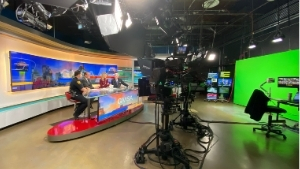Meteorology Marketing builds weather awareness and brand loyalty

Chances are you checked the forecast on your Smartphone before getting out of bed this morning. You’re not alone. 80% of people look at their phones within 15 minutes of waking up, and many check the weather.
If you didn’t get the forecast from an app, you could always ask Alexa or Siri. Quick weather updates are also displayed on video monitors installed on many gas pumps, taxi cabs, and office elevators. Listen to the radio, and you’ll hear the forecast every ten minutes or so.
Weather information is everywhere these days. A study from Magid reveals that 81% of local news viewers say they already know most of what they see in the weathercast. That aligns with Pew Research in which 76% of respondents in a nationwide survey say it’s easy to keep up to date with the weather.
 Here’s the challenge for local TV stations and broadcast meteorologists: How do we get consumers to watch us if they already know the forecast? What kind of weather content can we produce that consumers can’t get from a smartphone app or one of many other weather information sources?
Here’s the challenge for local TV stations and broadcast meteorologists: How do we get consumers to watch us if they already know the forecast? What kind of weather content can we produce that consumers can’t get from a smartphone app or one of many other weather information sources?
Local TV stations need a new weather coverage strategy that reflects the needs and habits of contemporary consumers. They must prove the value of their product in a way that connects with consumers on an intellectual, emotional, and visceral level by using some of the same tactics businesses use to build brand awareness: marketing.
THIS IS MARKETING
Marketing isn’t the same as advertising, sales, or self-promotion. With those, the focus is on the business. Marketing is focused on the consumer.
The American Marketing Association defines marketing as “communicating, delivering, and exchanging offerings (such as the forecast and other weather information) that have value for customers, clients, partners, (viewers and followers) and society at large.”
Marketing consultant Seth Godin explains it simply, “Marketing is the generous act of helping others.”
I love that phrase! To me, there’s a natural connection between meteorology and marketing. Generously help viewers and followers by effectively communicating essential weather information that has genuine value. It’s the difference between telling people you keep them safe during severe weather and actually doing it.
THIS IS METEOROLOGY MARKETING
Broadcast meteorologists usually do a good job connecting with viewers during severe weather. But you can’t build a loyal following if viewers only tune in on days when the weather suddenly changes. You need to deliver essential information every day, on every platform. Not just when the weather is severe and not just on TV.
READ MORE: BE THE GO-TO WEATHER EXPERT IN YOUR COMMUNITY
Be the source of essential weather information every day. Intentionally produce content that fulfills the weather brand promise. Demonstrates expertise and share your personality. Differentiate yourself in the market and separate yourself from the competition, including smartphone weather apps.
Here are three ways to incorporate Meteorology Marketing into the daily workflow and apply it to everything produced on-air, published online, and shared on social media.
DELIVER THE MESSAGE
Broadcast meteorologists are often told a good weathercast tells a good story. For scientific-minded people, however, the data is a story. That’s why many weathercasts are overproduced. Viewers are bombarded with endless satellite and radar loops along with multiple rainbow-colored maps filled with numbers and animated arrows.
Here’s a better suggestion. Edit the meteorology of the day into The Essential Message that represents information consumers want and need to know about the weather right now. Then, deliver the message.
Remember, research shows us that most viewers already know the forecast. So rather than trying to include everything in your weather hits, focus on one thing: The Essential Message. If the content doesn’t deliver, leave it out. That’s how you tell a good weather story.
DEMONSTRATE EXPERTISE AND SHARE PERSONALITY
 The biggest difference between broadcast meteorologists and a smartphone app is… themselves! An app can’t provide context and clarity. It can’t explain threats and impacts, why the weather will change, and how to prepare for it.
The biggest difference between broadcast meteorologists and a smartphone app is… themselves! An app can’t provide context and clarity. It can’t explain threats and impacts, why the weather will change, and how to prepare for it.
Differentiate yourself by demonstrating expertise and sharing your personality. Build teachable moments into your weather coverage without being overly scientific. Incorporate genuine emotional appeal and intelligent impacts without being preachy. Engage in conversation and invite your viewers and followers to participate in your coverage of their weather.
FULFILL THE BRAND PROMISE
As mentioned earlier, marketing isn’t the same thing as advertising, sales, or self-promotion. But it still needs to connect back to the TV station.
Support the station brand and your personal brand by showcasing the benefits of your proprietary technology and linking your on-air broadcasts with your online digital coverage. Push to station-branded apps and broadcasts to keep consumers engaged 24/7. It’s not self-promotion as long as the message you always deliver is essential information. Supporting the brand helps consumers remember where to find the weather information they need.
EVERY DAY ON EVERY PLATFORM
Producing digital content that complements and supplements the on-air coverage should be a priority for every local TV weather team. TV is still the number one source of news and weather information, but the second screen is the primary way many consumers stay up to date. That’s especially true of younger viewers.
Maximize your meteorology marketing efforts by delivering one cohesive essential message on all platforms. Be relentless. Show up every day, even on those days when the weather is just merely inconvenient. That’s how you build what Seth Godin calls a “Tribe.” TV folks call those people “loyal viewers.”
Tim Heller is an AMS Certified Broadcast Meteorologist, Talent Coach, and Weather Content Consultant. He helps broadcast meteorologists uplevel their performance and productivity by communicating more effectively and efficiently on-air, online, and on social media.
Read more News & Insights from HellerWeather
